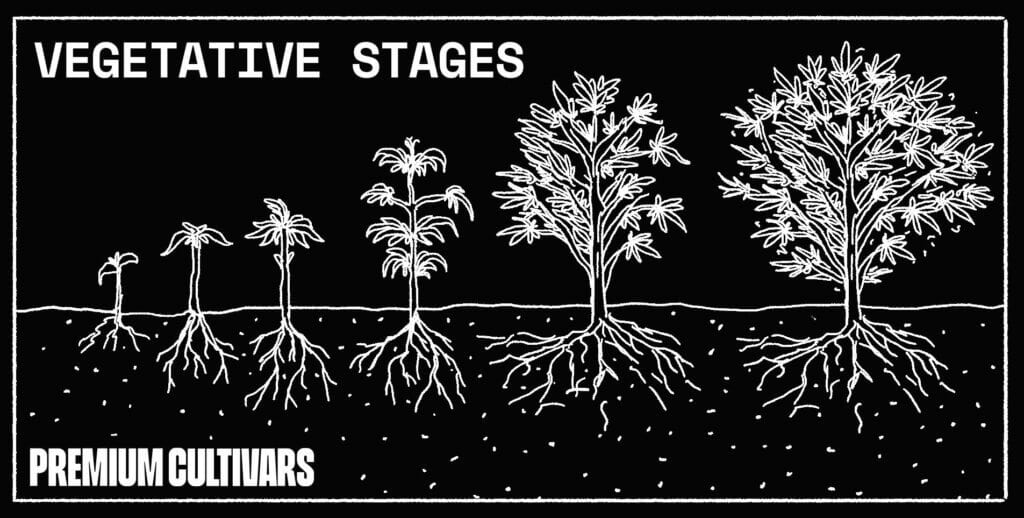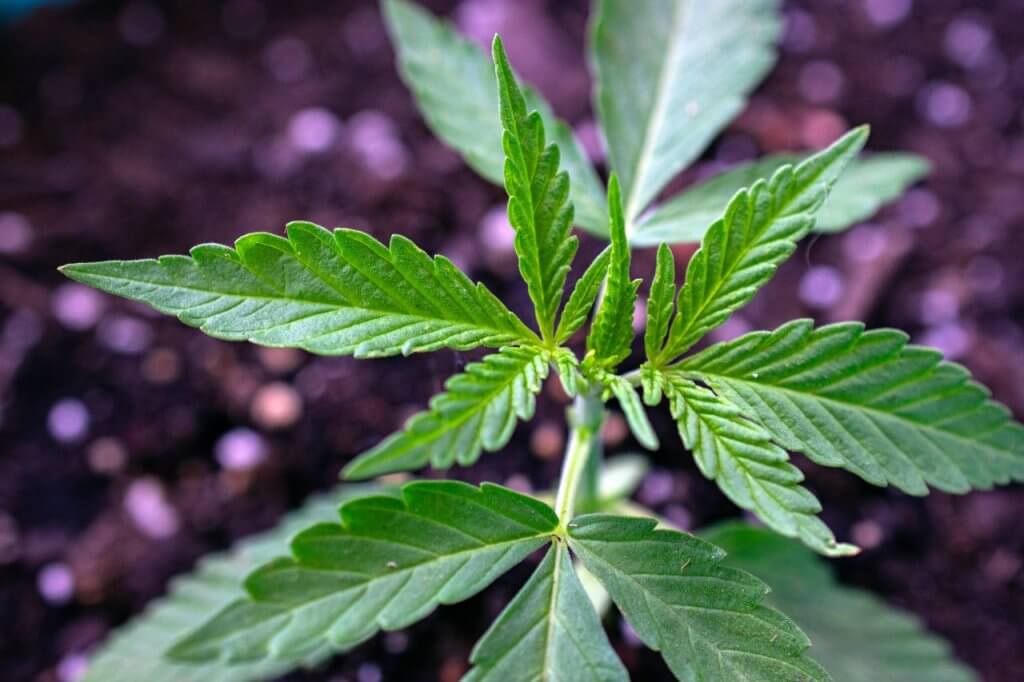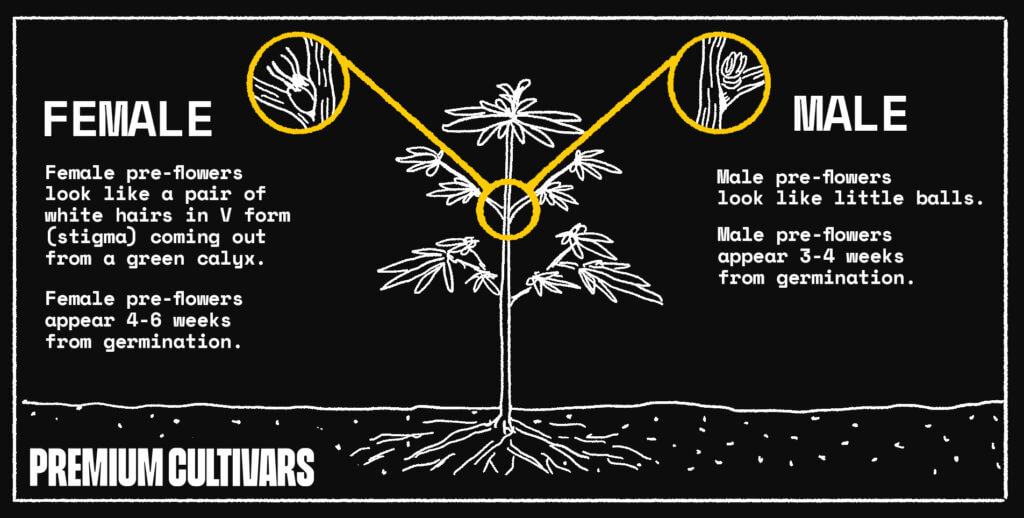Free Tropical Runtz seeds on orders over $150!
The vegetative stage of cannabis starts when your cannabis seedlings begin to sprout fan leaves and foliage. Once the cannabis vegetative stage begins, your seedlings will need to be transplanted into a pot, then the real growing begins.
A cannabis plant undergoes 3 main stages during its growth cycle, starting with the germination period, followed by the vegetative and then finally the flowering stage. Once the seeds have germinated, they will start to emerge out of the soil in the form of seedlings. At first, the plant will appear as just a stem with a couple o round leaves, then after about a week, the first true fan leaves will begin to form.
When the fan leaves start to form, this is the indication of the beginning of the vegetative stage.
During the vegetative stage, the plant will start to develop the majority of its structure and begin to grow big and strong. This phase is crucial to the plant’s development as it is preparing itself for the beginning of the flowering stage.
During the vegetative stage, you will notice a rapid increase in fan leaves popping up on different branches. These fan leaves are vital to the plant’s growth and development, as they help the most with the process of absorbing light and nutrients.
If the plant does not grow big and strong during this stage, it will not have the structural integrity and ability to withstand the flowering process.

The vegetative stage starts after the germination/seedling stage finishes.
The main indicators to look for that suggest the vegetative stage has begun are the development of fan leaves. You will also notice the plant getting larger and stronger as it settles into the vegetative stage. During the seedling stage, the plant is merely a stem with two round leaves, however, during the vegetative stage, you will see the development of branches, leaves, and nodes.
You don’t decide, only the plant itself has that power.
However, there are two schools of thought when it comes to when the veg stage actually begins.
There are a number of factors that influence how long your plant will stay in the vegetative stage. The genetics of the plant, the amount of light it receives, and the type of grow that you are doing all have a big effect on the length of the vegetative stage.
Autoflowering plants are completely different to photoperiod plants and will only stay in the vegetative stage for 3-5 weeks.
For most autos, they will transition from the vegetative stage to the flowering stage at around the end of week 5, no matter the lighting schedule.
The switch from veg to flower for photoperiod plants will happen when the light period changes.
Cannabis plants start to naturally transition into the flowering stage when the light cycle shortens.
This means that when growing indoors, you can manipulate the length of time the plant stays in the vegetative stage by altering the light cycle. To force a plant to stay in veg, it has to be under 18 hours of light per day. Once you are ready to switch it over to flower, the lighting per day needs to drop to 12 hours.
As the seasons change from summer to autumn, the plant recognizes that the light cycle is shortening and therefore will begin to transition into the flowering stage and start to grow buds.
If growers want to keep their outdoor plants in veg, then they will have to add supplemental light themselves.
One thing to remember when growing cannabis plants outdoors, is protecting them against pests. Insects and bugs can have a feast on your leaves and stems, while bigger animals such as birds can completely ruin your plant.
Make sure you are using the right organic pesticides to protect your plant from these pesky critters, and keep your plants protected by using a grow house or placing mesh around them to protect them from larger animals.
It is way easier to manipulate your cannabis plants when they are grown inside. If you want to keep your plants in the veg stage, you can simply alter the light exposure to lets say a 18/6 cycle, and keep it like this until your plants are ready for the flowering stage.
Once they are ready, you can reduce the light exposure to around 12 hours per day, and your plants will begin flowering and growing buds.
After the seed has germinated and the tap root has formed, a stem will emerge from the soil. This is the start of the vegetative phase. During the first week, you will also notice the formation of the first true fan leaves.

As your plant starts to get deeper into the vegetative stage, you will notice consistent growth. As a general rule, expect your plant to double in size every 10 days or so during the veg stage. You may also notice some pre-flowers by the end of week 4 if you are growing autos, which means the plant is finally revealing its sex.
You can also start to introduce some low-stress training techniques around the 4-week mark, as the plant should be strong enough to handle it.
If you are a beginner grower, try techniques such as topping and defoliation, as they are the lowest-stress techniques and are pretty hard to mess up.

This stage of the veg phase is all about nurturing growth and preparing your plant for the flowering stage. Make sure you are keeping a close eye on temperature, humidity and light exposure in your grow room, as these factors will help your plant grow big and strong.
Now is the final chance to transplant your plants. Have a good look at the root system, and if you can tell that it is getting too big for the plant’s container, you might need to transplant it into a bigger pot.
Keep in mind that your plant is well and truly not finished growing. There are still a few weeks of the veg stage left, as well as the stretching phase that happens during flowering.
Anything that happens between the end of the 6th week and the start of the flowering stage is commonly referred to as the later stages of veg. Most growers will switch there lights over to flower at around this time.
Your plant will continue to grow, and you will notice an abundance of fan leaves coming from all the branches.
If you are interested in training techniques such as ScrOG and Lollipopping, now is the time to do it. Any later than this, and you will probably miss your opportunity.
During this stage, you will also notice a bunch of pre-flowers, which should give you a good idea of how many budding sites your plant will have when it flowers.
It is totally up to you when you switch from the veg to the flowering stage. When growing indoors, that means switching the light cycle from an 18/6 cycle to a 12/12 cycle. If you are looking to grow one big plant, you can keep it in the veg stage for up to 12 weeks. However, if you are growing many smaller plants, you can switch after 4 to 5 weeks.
There are several tried-and-tested grow techniques that you can use to help improve the yield of your plants come harvest time. The majority of the grow techniques will produce the best results when implemented during the veg stage.
Topping is one of the most popular and commonly used grow techniques. It involves snipping the top of the main stem of your cannabis plant to promote lateral growth. By creating a wider rather than taller plant, it allows more of the budding sites, especially those at the top of the canopy, to get more light exposure.
More light exposure means more photosynthesis, which means more nutrients for the plant. When a plant gets more nutrients, it grows bigger and stronger, produces more buds, and yields a higher yield at harvest time.
ScrOG (Screen of Green) is a stress training technique used during the vegetative stage. This method involves placing a piece of mesh over the top of the plant and directing different branches through different parts of the mesh as it grows.
It is another way of encouraging the plant to grow wider, rather than tall. Again, wider plants allow more light exposure to reach to budding sites at the top of the canopy and will promote higher yields when you harvest.
Lollipopping is a method of trimming your plants in order to redirect nutrients to certain parts of the plant. On a cannabis plant, you are most likely to get your biggest and best buds from branches that are at the top of the plant. The ones at the bottom are often shaded by the above canopy, and therefore get less light exposure and less nutrients.
Lollipopping involves cutting off the bottom branches during the vegetative stage. This means all the nutrients that the plant is getting from the soil and from light exposure, will be redirected to the buds at the top of the plant.
By using this technique, you can get far bigger and far healthier buds from your plant, increasing the size of your yield and the quality of your harvest.
This is a low-stress training technique that almost all growers use, and you should too. It is super simple yet very effective. Defoliation simply means pruning away excess leaves so that more light can reach the budding sites. During defoliation, it is also important to trim away any leaves that are showing signs of disease, are getting yellow in color, or have already died.
During the vege stage, your plant is taking in as many nutrients as it can to grow big and strong. For this reason, it is super important to give it the right types of nutrients at the right times.
In the vegetative stage, your plant needs a heap of nitrogen, which helps the growth of the stems and leaves. It also needs potassium to regulate the opening and closing of stomata and to produce energy. Magnesium is also needed during this stage in order to power photosynthesis.
A healthy organic soil should have plenty of all these vegetative stages nutrients. However, if you are doing an hydro grow, you will need to use nutrients to make sure your plant gets what it needs.
Water is another important element to a successful grow. Cannabis plants need water to help the nutrients travel from the soil, up the stem and to the leaves. Make sure you are not overwatering your plant. Overwatering can starve the roots of air and cause root rot.
A good guideline to go by is waiting until at least the top 3cm of the soil is dry before you water your plant again.
The transition stage from vegetative to flowering is an exciting time for any grower. The flowering stage is when you start to see your hard work paying off. You will get to watch buds forming from the flower sites and start getting that delicious dank smell that we all love as cannabis enthusiasts.
In order for your plant to transition, a few things have to happen.
If you are growing outdoors, this will happen naturally. As the months move from summer to autumn, and light levels throughout the day reduce, your plant will automatically begin to transition into the flowering stage.
For indoor grows, this is different. It is up to you as the grower to reduce the light exposure that your plant gets each day. We recommend moving to a 12/12 cycle to initiate the flowering stage. Those 12 hours of darkness that your plant gets will be enough to signal it to start flowering.You are making the plant think that winter is coming.
During the first 10–14 days of the flowering stage, your plant will undergo what is known as “the stretch”. You will notice a huge increase in size over a very short period of time. It all depends on the strain that you are growing; however, some strains can almost double in size during the flowering stretch, so be ready!
It is important to be aware of this process, especially if you are using training methods such as ScrOG. Your plant needs plenty of room to spread its wings during the stretch phase.
If you are growing more than one plant at a time, especially indoors, it is crucial that they are spaced far enough apart to allow for the stretch.
The nutrional requirements will also change as the plants begin to flower. The need for nitrogen drops off dramatically, and the demand for phosphorus and potassium increases. It is important to adjust your nutrient regimen accordingly, as too much nitrogen during the flowering stage can result in stunted growth and reduced yields.
You may also notice a change in the appearance of your plant’s leaves. As they transition from the vegetative stage to the flowering stage, the leaves may begin to yellow and fall off.
This is a natural process as the plant redirects its energy towards flower production.
During this time, it is crucial to closely monitor your plants’ nutrient levels and make adjustments as needed. Some growers also choose to introduce bloom-specific nutrients at this stage to further support cannabis flower development.
So, there we have it! Everything you need to know to get your crop over that vegetative line and into flowering. Remember to keep a close eye on your plants and make adjustments as needed.
And be ready. Flower production puts a lot of strain on your plants, and they may require more water, nutrients, and support during this stage.
But with proper care and attention, you’re only about 6 to 7 weeks away from being rewarded with potentially the biggest bundle of bud that you have ever laid eyes on!





Offers
This product is not for use by or sale to persons under the age of 18. This product should be used only as directed on the label. It should not be used if you are pregnant or nursing. Consult with a physician before use if you have a serious medical condition or use prescription medications. A doctor’s advice should be sought before using any hemp products. All trademarks and copyrights are property of their respective owners and not affiliated with nor do they endorse this product. These statements have not been evaluated by the FDA. This product is not intended to diagnose, treat, cure or prevent any disease. By using this site you agree to follow the Privacy Policy and all Terms & Conditions printed on this site. All products contain less than 0.3% Cannabinoid-compliant with applicable Federal Laws. Please make yourself aware of any and all applicable laws regarding hemp in your jurisdiction. Premium Cultivars accepts no liability or responsibility regarding germination laws in any specific locale state or national jurisdictions.THCA products are not available for shipment to the following states: Hawaii, Idaho, Minnesota, Oregon, Rhode Island, Utah, Vermont *Note: Products with Total THC content above 0.3% must not be shipped to these states.
We want to help you get your hands on the seeds you want, take 20% off your next purchase when you enter your email below!
We want to help you get your hands on the seeds you want, take 20% off your next purchase when you enter your email below!